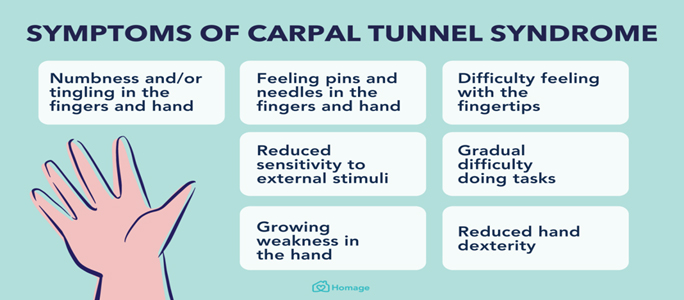Carpal Tunnel Syndrome (CTS)
Understanding Carpal Tunnel Syndrome
Carpal
tunnel syndrome (CTS) is a common condition that affects the median nerve in
your wrist. The median nerve passes through a narrow passageway in the wrist
called the carpal tunnel. When this nerve is under too much pressure, it can
lead to symptoms like pain, numbness, tingling, and weakness in your hand and
fingers.
What causes
it?
Anything
that causes swelling or irritation in the wrist can lead to carpal tunnel
syndrome. This can include:
- Repetitive strain injuries
- Arthritis
- Sprains
- Broken wrist bones
(fractures)
- Ganglion cysts
You may also
be at higher risk if you engage in repetitive hand and wrist motions at work,
such as swinging a hammer, or if you use vibrating power tools like drills.
Other factors that can increase your risk include being over 40 years old,
being a woman, or being pregnant. The condition can also be hereditary. Certain
health conditions like rheumatoid arthritis, diabetes, and obesity can also
increase your risk.
Signs and symptoms

Common Symptoms
The symptoms
of carpal tunnel syndrome usually develop slowly. At first, you might
experience minor issues that worsen over time. The most common symptoms are:
- Numbness or tingling in your wrist, hand, or fingers, especially the
fingertips
- Pain in your wrist, hand, or fingers
- Difficulty using your hands to hold or control objects, such as a phone, pen, or steering
wheel
You may also
experience a reduced sensitivity to external stimuli, reduced hand dexterity,
and gradual difficulty with daily tasks.
Anyone can develop
carpal tunnel syndrome, but some people are more likely to, including:
People who do repetitive motions with their
hands and wrists for work (swinging a hammer, for example)
People who use power tools that vibrate
(like drills or jackhammers)
·
Pregnant
women
·
Women
·
Adults
over the age of 40
People whose biological relatives have
carpal tunnel syndrome (it can be hereditary, or passed through generations in
families)
Having certain
health conditions can increase your carpal tunnel syndrome risk, including:
·
Rheumatoid
arthritis
·
Gout
·
Hypothyroidism
·
Diabetes
·
Obesity
·
Amyloidosis
How to manage carpal tunnel syndrome?
The most common
carpal tunnel treatments include modifying your daily routine, supporting and
strengthening your wrist and taking medication:
·
Wearing
a splint (especially at night): A splint will hold your wrist in a neutral
position to take pressure off your median nerve.
·
Physical
therapy: A physical therapist can help you strengthen muscles around your wrist
and increase your flexibility.
·
Changing
your posture or working environment: An occupational therapist can suggest ways
to modify how you do everyday tasks to move safely and more comfortably. You
might need to change how you sit or stand, how you position your keyboard or
make other posture tweaks.
An Ayurvedic Perspective
In Ayurveda,
carpal tunnel syndrome can be compared to a dysfunction of Vata, the
factor that governs peripheral nerve activity. This can first manifest as
numbness in the hands, followed by an increase in Vata, which shows up as pain and muscle weakness or wasting in
the hand region.
Ayurvedic
treatment protocols are tailored to the individual and can include various methods
such as Oil Massage, Local Steam application (Kizhi), Medicated Bandaging, and
Marma Therapy.
Dr. Sayyed Mohammed Nadirsha
Medical Officer
Dr. P. Alikutty’s Ayurveda and Modern Hospital - Kottakkal
Check out these products from Dr. P. Alikutty’s Ayurveda Pharmaceuticals - Kottakkal
1. Pain Clear Oil: Click to purchase
2. Pain Clear Balm: Click to purchase
3. Painclear Upanaha Choornam : Click to purchase
4. Ruja Capsule: Click to purchase
 en
en
 العربية
العربية









